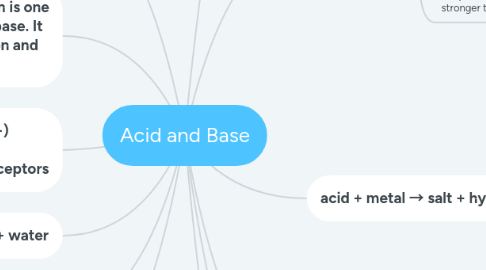
1. Indicators to differentiate acid and Base
1.1. Phenolphthalein
1.1.1. Alkaline = pink o Acidic = colourless
1.2. Methyl orange
1.2.1. o Alkaline = yellow
1.2.2. o Acidic = red
1.3. Litmus
1.3.1. Litmus paper
1.3.2. ▪ Blue litmus paper goes red in acidic & stays blue in alkaline
1.3.3. ▪ Red litmus paper goes blue in alkaline & stays red in acidic
1.3.4. Litmus solution ▪ Alkaline = blue ▪ Acidic = red
2. pH Scale
2.1. o pH 7 is neutral
2.2. o < pH 7 is acidic (the closer to 0, the stronger the acid)
2.2.1. HCl, Nitric acid and sulfuric acid are also strong acids.
2.2.2. Ethanoic acid weak acid
2.3. o > pH 7 is alkaline (the closer to 14, the stronger the alkali)
2.3.1. Potassium hydroxide (KOH) Sodium hydroxide (NaOH)
2.3.2. Ammonia. weak base
3. Acids produce H+ ions in aqueous solutions Alkalis produce OH- ions in aqueous solutions
3.1. metal oxides, metal hydroxides and ammonia are base
4. A neutralization reaction is one between an acid and a base. It is an exothermic reaction and form Salt + water
5. acids are proton (H+) donors bases are proton acceptors
6. acid + base → salt + water
7. acid + metal → salt + hydrogen
7.1. ● 2HCl + 2Na -> 2NaCl + H2
7.2. experiment to prepare a pure, dry sample of a soluble salt, starting from an insoluble reactant
7.2.1. add excess insoluble base to the acid ● filter to remove unreacted base ● heat the solution so that water evaporates and crystals of the salt remain
7.2.1.1. prepare a sample of pure, dry hydrated copper (II) sulfate crystals starting from copper (II) oxide
7.3. describe an experiment to prepare a pure, dry sample of a soluble salt, starting from an acid and alkali
7.3.1. use a titration to find the exact volume of the alkali that reacts with the acid ● mix the exact volumes of the acid and base ● warm solution so that water evaporates and crystals of the salt remain
7.4. describe an experiment to prepare a pure, dry sample of an insoluble salt, starting from two soluble reactants
7.4.1. mix solutions of 2 soluble reactants ● filter mixture (insoluble salt will remain on filter paper) ● wash salt with distilled water ● leave salt to dry
7.4.1.1. prepare a sample of pure, dry lead (II) sulfate
